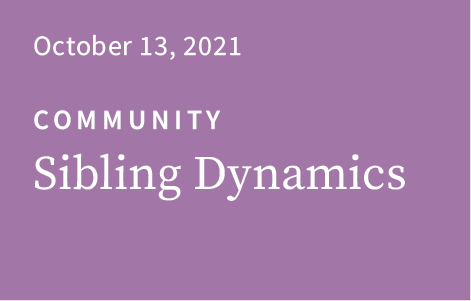Transcript
Sibling Dynamics
I’m not sure what I was expecting when I called my brother to tell him our mother and stepfather, Steve, were moving to Swarthmore, Pennsylvania, so my wife and I could help take care of them. Perhaps a simple thank you or an offer to help. Steve had advanced Alzheimer’s disease, with agitation at times, and our physically frail mother had been struggling to manage him. Instead of thanking me, though, my brother said, “Well, this is on you now.” He made clear he didn’t want to be involved in any caregiving and that I was on my own. I felt coldly rejected. It has cast a pall on our relationship ever since, even years after Steve’s death.
Caring for parents with dementia can also bring out the best in adult siblings. They can rally together to develop a coordinated caregiving plan to help a parent live as well as possible. One sibling can do the shopping; another deal with insurance; a third, organize the home health aides. They can put their heads together to solve the logistical problems that inevitably arise. They can grieve their parent’s decline together, taking solace in each other’s company.
But in my 30 years as a clinical psychologist, educator, and writer specializing in helping dementia caregivers, I have too often seen sibling groups come apart under the pressure of caregiving. Ugly, old dynamics and rivalries crop up. Disappointment, anger, and bitterness can result. None of this intrafamily acrimony is helpful to the parent with dementia. Most of these sibling relationships are weakened, not strengthened, by the power struggles and finger-pointing.
Though sibling-caregiver conflict is common, research is relatively sparse. However, about 10 years ago, Karl Pillemer, a Cornell University sociologist and foremost researcher in this area, published two interesting findings.
First, his research found that the division of caregiving labor among adult siblings is rarely equitable or random. One or two siblings usually bear the brunt of the work. The most common sibling to become the primary caregiver is the youngest daughter. The second most common is the oldest daughter.
Pillemer’s group also noted that while parents aren’t supposed to play favorites among their children, they do, at least when it comes to which child they want to help them as they age. The parent’s views, sometimes verbalized, sometimes only implied, can have a major impact on how the adult sibling group divvies up the labor.
Whether counseling individual caregivers who are angry at their sibling, or consulting for sibling groups actively trying to work together better, I try to address factors that influence their dynamics. Gender is the most important factor. There’s often an unspoken expectation that the women will do more caregiving than the men. Sometimes this reflects the gender values of the sibling group, but not always. In my experience, the brothers rarely if ever acknowledge, much less support, their caregiving sisters. Their refusal to participate in the parent’s care, even for legitimate reasons such as work duties or their own family responsibilities, will almost always result in conflict and lingering bad feelings. Even neglectful brothers must make some contribution, however small.
Another common factor influencing sibling dynamics is birth order. In childhood, it was normal for older siblings to direct their younger siblings. There’s no reason for this pattern to abide in adulthood. Yet in some families, the oldest sister or brother still implicitly assumes the role of primary decision-maker—which doesn’t usually sit well with the others.
A third variable is geographic proximity. The sibling who lives with or around the corner from the parent with dementia—i.e., the frontline sibling—will necessarily do more caregiving. The siblings residing farther away, sometimes on the other side of the country, must acknowledge the frontline sibling’s sacrifices and find meaningful ways of being supportive. Interestingly, I’ve seen that that geographically proximal sibling is often the youngest or oldest daughter that Pillemer had discussed.
To help sibling caregivers work together as an effective support team, I use a three-step process.
First, I point out that the emotional stakes are high. I assure them that they can expect each sibling to observe and judge the others’ level of care during Mom or Dad’s hour of need. This is a defining moment in their relationship: The degree of kindness, cooperation, and compassion they show toward one another during this challenging period will either strengthen or weaken their bonds long after their parent has died, and possibly for the rest of their lives. That usually gets their attention to the goal at hand.
Second, we turn to developing consensus about the parent’s diagnosis and needs for care, which can be interpreted very differently by different siblings—especially during the early phases of dementia when memory lapses may still be periodic and confusion just mild. Often, one will insist the parent get evaluated while the other will argue that the parent is fine. Until they are at least somewhat on the same page, it will be impossible for them to move forward as an effective team. I recommend getting the medical reports and possibly speaking with the parent’s doctor as a group to begin to develop a common conception of a parent’s diagnosis and needs for support. I also suggest agreeing on a platform for regularly sharing the parent’s medical updates—this could be a group text, group email, family website, or other means to keep everyone informed, in touch, and aligned.
The third important step is for the siblings to have a process in place to respectfully confer and take stock of the caregiving plan. I advise meeting at least quarterly in person or by video conference to review the parent’s status, determine the parent’s current care needs, and share the current life demands of each sibling. With that information in hand, the group is better positioned to divvy up tasks as fairly as possible, even while acknowledging that one sibling (e.g., the youngest daughter who lives closest) will still do most of the work. At each quarterly meeting, this process should be repeated and the plan fine-tuned in a manner that is responsive to the changing circumstances of each sibling.
These sibling caregiving conversations can be beneficial in and of themselves. Once some of the initial high emotion subsides, siblings may learn to better listen to each other, not just as children of a common parent but as mutually appreciative adults. They may come to trust and even like each other more. While the goal is to help the parent feel cared for, the siblings, too, may feel cared for by one another. At the end of the day, after the parent has passed, I want them to be able to say they did right by Mom or Dad and by each other.
Barry J. Jacobs, PsyD
Principal
Health Management Associates
www.loveandmeaning.com

